[English] 日本語
 Yorodumi
Yorodumi- PDB-2k14: Solution structure of the soluble domain of the NfeD protein YuaF... -
+ Open data
Open data
- Basic information
Basic information
| Entry | Database: PDB / ID: 2k14 | ||||||
|---|---|---|---|---|---|---|---|
| Title | Solution structure of the soluble domain of the NfeD protein YuaF from Bacillus subtilis | ||||||
 Components Components | YuaF protein | ||||||
 Keywords Keywords | UNKNOWN FUNCTION / YuaF / Bacillus subtilis / NfeD-like protein / cellular stress | ||||||
| Function / homology | Nucleic acid-binding proteins / OB fold (Dihydrolipoamide Acetyltransferase, E2P) / membrane raft / Nucleic acid-binding, OB-fold / Beta Barrel / Mainly Beta / plasma membrane / Membrane protein NfeD2 Function and homology information Function and homology information | ||||||
| Biological species |  | ||||||
| Method | SOLUTION NMR / torsion angle dynamics, simulated annealing | ||||||
| Model details | This PBD entry contains the structure of residues 97 to 174 of YuaF (residues 7 to 84 of this entry) ...This PBD entry contains the structure of residues 97 to 174 of YuaF (residues 7 to 84 of this entry). In addition, the structure includes six further residues (1-6) that originate from the MBP fusion construct. | ||||||
 Authors Authors | Walker, C.A. / Hinderhofer, M. / Witte, D.J. / Boos, W. / Moller, H.M. | ||||||
 Citation Citation |  Journal: J.Biomol.Nmr / Year: 2008 Journal: J.Biomol.Nmr / Year: 2008Title: Solution structure of the soluble domain of the NfeD protein YuaF from Bacillus subtilis. Authors: Walker, C.A. / Hinderhofer, M. / Witte, D.J. / Boos, W. / Moller, H.M. | ||||||
| History |
|
- Structure visualization
Structure visualization
| Structure viewer | Molecule:  Molmil Molmil Jmol/JSmol Jmol/JSmol |
|---|
- Downloads & links
Downloads & links
- Download
Download
| PDBx/mmCIF format |  2k14.cif.gz 2k14.cif.gz | 477.2 KB | Display |  PDBx/mmCIF format PDBx/mmCIF format |
|---|---|---|---|---|
| PDB format |  pdb2k14.ent.gz pdb2k14.ent.gz | 399.6 KB | Display |  PDB format PDB format |
| PDBx/mmJSON format |  2k14.json.gz 2k14.json.gz | Tree view |  PDBx/mmJSON format PDBx/mmJSON format | |
| Others |  Other downloads Other downloads |
-Validation report
| Summary document |  2k14_validation.pdf.gz 2k14_validation.pdf.gz | 346.7 KB | Display |  wwPDB validaton report wwPDB validaton report |
|---|---|---|---|---|
| Full document |  2k14_full_validation.pdf.gz 2k14_full_validation.pdf.gz | 430 KB | Display | |
| Data in XML |  2k14_validation.xml.gz 2k14_validation.xml.gz | 22.2 KB | Display | |
| Data in CIF |  2k14_validation.cif.gz 2k14_validation.cif.gz | 39.6 KB | Display | |
| Arichive directory |  https://data.pdbj.org/pub/pdb/validation_reports/k1/2k14 https://data.pdbj.org/pub/pdb/validation_reports/k1/2k14 ftp://data.pdbj.org/pub/pdb/validation_reports/k1/2k14 ftp://data.pdbj.org/pub/pdb/validation_reports/k1/2k14 | HTTPS FTP |
-Related structure data
| Similar structure data | |
|---|---|
| Other databases |
|
- Links
Links
- Assembly
Assembly
| Deposited unit | 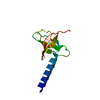
| |||||||||
|---|---|---|---|---|---|---|---|---|---|---|
| 1 |
| |||||||||
| NMR ensembles |
|
- Components
Components
| #1: Protein | Mass: 8850.825 Da / Num. of mol.: 1 / Fragment: C-terminal domain (UNP residues 97-174) Source method: isolated from a genetically manipulated source Source: (gene. exp.)  Description: The plasmid pHIHO1421 was constructed by fusing the coding sequence of residues 97-174 of YuaF to the 3'-end of the malE gene containing an additional thrombin cleavage site. The soluble ...Description: The plasmid pHIHO1421 was constructed by fusing the coding sequence of residues 97-174 of YuaF to the 3'-end of the malE gene containing an additional thrombin cleavage site. The soluble C-terminal domain of YuaF was generated by cleaving off the malE part by digestion with thrombin. Gene: yuaF / Production host:  |
|---|---|
| Sequence details | THIS PBD ENTRY CONTAINS THE STRUCTURE OF RESIDUES 97 TO 174 OF YUAF (RESIDUES 7 TO 84 OF THIS ENTRY) ...THIS PBD ENTRY CONTAINS THE STRUCTURE OF RESIDUES 97 TO 174 OF YUAF (RESIDUES 7 TO 84 OF THIS ENTRY). IN ADDITION, THE STRUCTURE INCLUDES SIX FURTHER RESIDUES (1-6) THAT ORIGINATE FROM THE MBP FUSION CONSTRUCT. |
-Experimental details
-Experiment
| Experiment | Method: SOLUTION NMR Details: This PBD entry contains the structure of residues 97 to 174 of YuaF (residues 7 to 84 of this entry). In addition, the structure includes six further residues (1-6) that originate from the MBP fusion construct. | ||||||||||||||||||||||||||||||||||||||||||||||||||||||||||||||||
|---|---|---|---|---|---|---|---|---|---|---|---|---|---|---|---|---|---|---|---|---|---|---|---|---|---|---|---|---|---|---|---|---|---|---|---|---|---|---|---|---|---|---|---|---|---|---|---|---|---|---|---|---|---|---|---|---|---|---|---|---|---|---|---|---|---|
| NMR experiment |
|
- Sample preparation
Sample preparation
| Details |
| ||||||||||||||||||||||||||||||||||||||||||||||||||||
|---|---|---|---|---|---|---|---|---|---|---|---|---|---|---|---|---|---|---|---|---|---|---|---|---|---|---|---|---|---|---|---|---|---|---|---|---|---|---|---|---|---|---|---|---|---|---|---|---|---|---|---|---|---|
| Sample |
| ||||||||||||||||||||||||||||||||||||||||||||||||||||
| Sample conditions | Ionic strength: 300 / pH: 7.5 / Pressure: ambient atm / Temperature: 280 K |
-NMR measurement
| NMR spectrometer |
|
|---|
- Processing
Processing
| NMR software |
| ||||||||||||||||||||||||
|---|---|---|---|---|---|---|---|---|---|---|---|---|---|---|---|---|---|---|---|---|---|---|---|---|---|
| Refinement | Method: torsion angle dynamics, simulated annealing / Software ordinal: 1 Details: 400 Starting structures for refinement were generated with the final set of constraints by torsion angle dynamics in CYANA 2.0., Refinement of the final structural ensemble was carried out ...Details: 400 Starting structures for refinement were generated with the final set of constraints by torsion angle dynamics in CYANA 2.0., Refinement of the final structural ensemble was carried out by molecular dynamics simulated annealing in AMBER 8. The 100 structures with lowest target function in CYANA 2.0 were imported into AMBER 8, minimized and subjected to simulated annealing in vacuum with charges reduced to 20% of their original value. The final round of simulated annealing was carried out within a generalized-Born solvation model with full charges followed by energy minimization. Constraints from CYANA were translated into AMBER 8 format taking stereospecific assignments, pseudoatom corrections and NOE-averaging into account. | ||||||||||||||||||||||||
| NMR constraints | NOE constraints total: 1526 / NOE intraresidue total count: 379 / NOE long range total count: 522 / NOE medium range total count: 214 / NOE sequential total count: 411 | ||||||||||||||||||||||||
| NMR representative | Selection criteria: fewest violations | ||||||||||||||||||||||||
| NMR ensemble | Conformer selection criteria: structures with the least restraint violations Conformers calculated total number: 400 / Conformers submitted total number: 20 / Maximum lower distance constraint violation: 0 Å / Maximum upper distance constraint violation: 0.17 Å | ||||||||||||||||||||||||
| NMR ensemble rms | Distance rms dev: 0.088 Å |
 Movie
Movie Controller
Controller


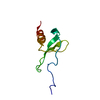

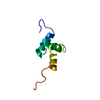
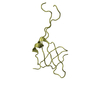
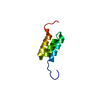

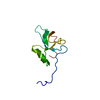
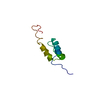
 PDBj
PDBj HSQC
HSQC